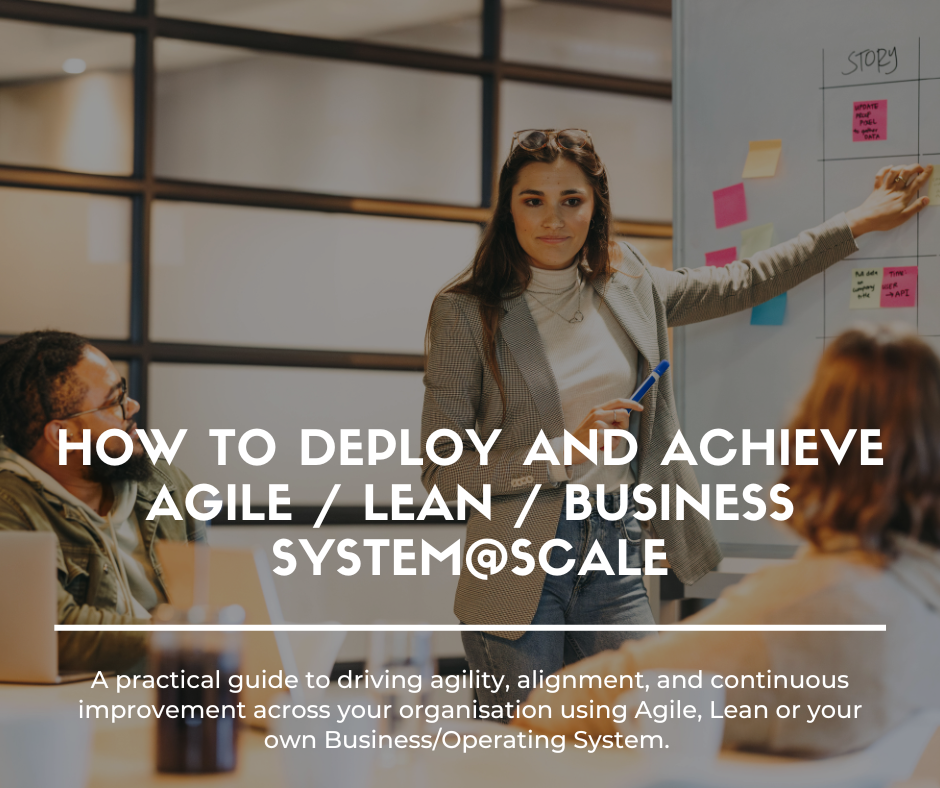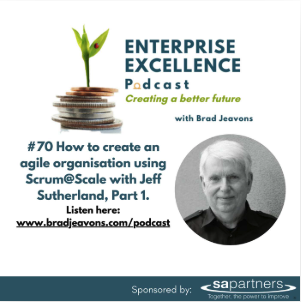How to Deploy and Achieve Agile / Lean / Business System@Scale

Establish the Foundations of an Agile/Lean Business System
Start by building your organisation on the key principles of:
- Stability: Create consistent routines, expectations, and standards.
- Transparency: Visualise work, performance, improvement, and challenges.
- Inspection: Routinely assess systems and results with the intent to learn.
- Adaptation: Adjust rapidly based on new insights, obstacles, or needs.
- Velocity & Innovation: Continuously enhance speed and value delivery.
These principles set the cultural and operational tone for agility at scale.
1. Create a Clear Vision and Cascade Strategic Goals
Executive Ownership
Executives should:
- Capture the Voice of the Customer (VoC) (internal and external).
- Create a meaningful vision aligned to customer value and purpose.
- Set challenging but clear goals (lag and lead indicators).
- Revisit team charters regularly, reviewing behaviours and key behavioural indicators (KBIs) to support culture.
Strategic Breakdown
Using Large Scale Planning, break down strategy:
- Mountains → Strategic initiatives
- Boulders → Quarterly deliverables
- Rocks → Monthly priorities
- Pebbles → Sprint-ready user stories
Ensure each item aligns with a product backlog, owned and prioritised by Product Owners.
2. Execute Through the Agile Scrum Cycle
Sprint Planning
Each team defines a:
- Sprint vision and goal.
- Selects stories based on readiness (DoR) and “yesterday’s weather”.
- Establishes a Definition of Done (DoD).
Daily Scrums
Teams meet daily around a transparent board:
- Inspect Kanban, burndown charts, sprint goals.
- Address cultural topics, progress, RCA for blockers, and set focus.
The Scrum Master leads this process, ensuring team performance and improvement.
Scrum of Scrums & Meta Scrum
- Scrum of Scrums: Removes blockers across teams.
- Meta Scrum: Coordinates backlog and delivery at scale.
- Executive Action Team: Solves top-level impediments.
- Executive Meta Scrum (EMS): Oversees backlog planning and adaption.
3. Foster Learning and Improvement
Sprint Reviews
- Gather customer and stakeholder feedback.
- Adjust product backlog based on learnings.
Sprint Retrospectives
- Reflect on what to start, stop, continue, and improve.
- Use Root Cause Analysis (RCA) on team and process challenges.
- Prioritise at least one improvement story into the next sprint.
4. Build a Maturity Index to Guide Your Journey
To overcome challenges and celebrate wins, introduce a Business System Maturity Index:
- Use a simple 1–5 scale aligned to your culture and ways of working:
- 1 – Ad hoc: No consistent system or behaviours.
- 2 – Reactive: Some routines but not embedded.
- 3 – Structured: Standard practices applied with some adaptation.
- 4 – Proactive: Culture-driven application, regular learning.
- 5 – Adaptive: Continual improvement embedded, teams self-reflect and self-correct.
Track your progress across areas such as:
- Strategic alignment
- Backlog health
- Daily execution rhythms
- Team empowerment
- Leadership behaviours
- Cultural impact
Reassess quarterly to identify growth and bottlenecks.
5. Develop Adaptive Leadership at All Levels
Strong systems require strong leadership. Develop leaders who serve the growth of others and drive performance through clarity and support.
Key Capabilities to Build:
- Adaptive Leadership: Read the system and adapt styles to serve the team’s needs.
- Leader Standard Work (LSW): Establish daily, weekly, and monthly routines for coaching, engagement, and improvement.
- Look Listen Learn (LLL) Events:
- Look: Observe the team, work area, and systems.
- Listen: Engage in dialogue, ask open-ended questions.
- Learn: Reflect on insights and take personal and systemic action.
Use these events not just to coach others but to improve yourself first—model the behaviours and mindset you expect across your organisation.
6. Sustain the System with Rhythm and Discipline
Use regular cadences to embed the system:
- Daily: Scrum meetings
- Weekly: Team reviews and leadership reflections
- Bi-weekly: Sprint reviews and retrospectives
- Monthly: Meta scrums and improvement deployment
- Quarterly: Strategic resets, maturity assessment, capability building
Document and visualise your journey publicly—celebrate milestones and improvements to reinforce culture and momentum.
Conclusion
Scaling Agile/Lean/Business Systems is not just about tools and routines—it’s about evolving the culture, leadership, and ways of working that drive sustainable results. Use this guide to shape your journey, track your progress, and build a learning organisation that adapts and excels.
To learn more visit www.enterpriseexcellencegroup.com.au and check out the resources section for additional information and resources to help you on your organisations journey. Also check out the book Leading Excellence which is a great read or Listen (Available on any audio book app).
Click on the images below to learn more

.svg)







